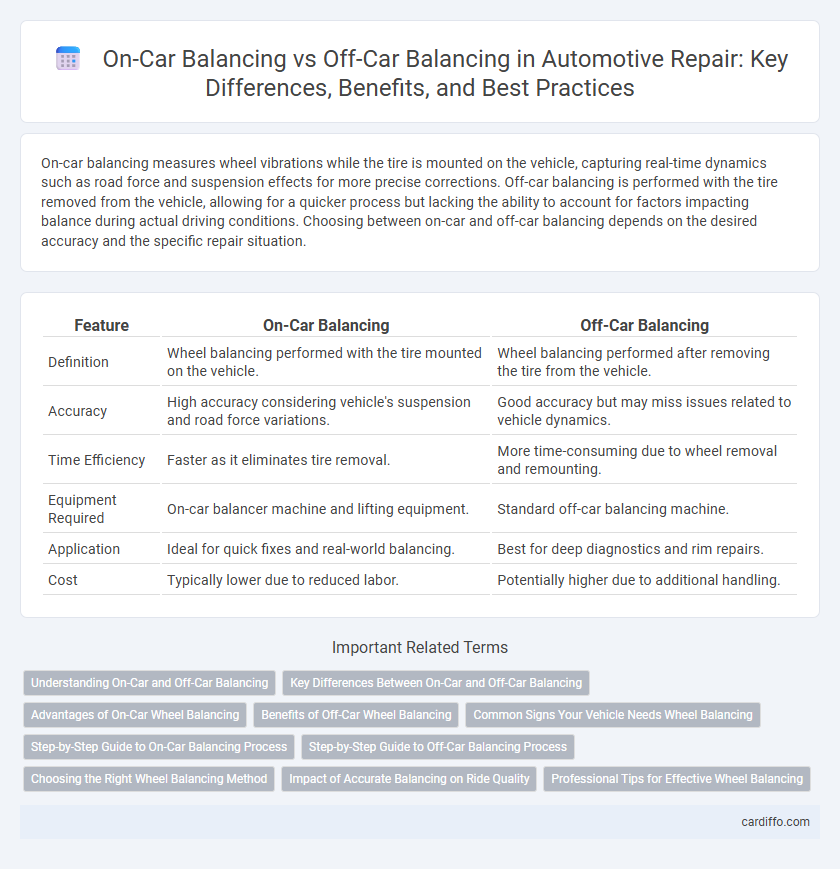On-car balancing measures wheel vibrations while the tire is mounted on the vehicle, capturing real-time dynamics such as road force and suspension effects for more precise corrections. Off-car balancing is performed with the tire removed from the vehicle, allowing for a quicker process but lacking the ability to account for factors impacting balance during actual driving conditions. Choosing between on-car and off-car balancing depends on the desired accuracy and the specific repair situation.
Table of Comparison
| Feature | On-Car Balancing | Off-Car Balancing |
|---|---|---|
| Definition | Wheel balancing performed with the tire mounted on the vehicle. | Wheel balancing performed after removing the tire from the vehicle. |
| Accuracy | High accuracy considering vehicle's suspension and road force variations. | Good accuracy but may miss issues related to vehicle dynamics. |
| Time Efficiency | Faster as it eliminates tire removal. | More time-consuming due to wheel removal and remounting. |
| Equipment Required | On-car balancer machine and lifting equipment. | Standard off-car balancing machine. |
| Application | Ideal for quick fixes and real-world balancing. | Best for deep diagnostics and rim repairs. |
| Cost | Typically lower due to reduced labor. | Potentially higher due to additional handling. |
Understanding On-Car and Off-Car Balancing
On-car balancing measures wheel balance while the tire is mounted on the vehicle, accounting for factors like suspension and road force variations. Off-car balancing is performed with the tire removed, using a specialized machine to detect uneven weight distribution independent of vehicle influences. Understanding these methods helps technicians select the optimal balancing approach to improve ride quality and extend tire life.
Key Differences Between On-Car and Off-Car Balancing
On-car balancing measures wheel balance by rotating the wheel directly on the vehicle, accounting for real-world conditions such as the weight of the hub and brake components, which off-car balancing does not simulate. Off-car balancing involves removing the wheel and mounting it on a balancing machine, providing precise imbalance measurements without the influence of vehicle-specific factors. The key differences lie in accuracy and relevancy; on-car balancing offers dynamic balance assessment with actual driving conditions, whereas off-car balancing provides static balance correction in a controlled environment.
Advantages of On-Car Wheel Balancing
On-car wheel balancing offers precise correction by measuring wheel balance under actual driving conditions, ensuring enhanced vehicle stability and smoother handling. This method identifies dynamic imbalances caused by the entire assembly, including the tire, wheel, and braking elements, which off-car balancing often overlooks. Incorporating real-time spin data allows technicians to achieve superior accuracy, reduce vibration, and extend tire and suspension component lifespan.
Benefits of Off-Car Wheel Balancing
Off-car wheel balancing ensures precise measurement by isolating the wheel from vehicle influence, resulting in more accurate weight placement for smoother rides and reduced tire wear. This method allows technicians to identify and correct imbalances on both sides of the wheel, which on-car balancing sometimes misses due to suspension interferences. Enhanced accuracy from off-car balancing contributes to improved vehicle handling, fuel efficiency, and extended tire lifespan.
Common Signs Your Vehicle Needs Wheel Balancing
Uneven tire wear, vibrations in the steering wheel or floorboard, and pulling to one side while driving are common signs your vehicle needs wheel balancing. On-car balancing corrects imbalances without removing the tire, ensuring precise adjustments by measuring vibrations directly on the vehicle. Off-car balancing requires removing the tire from the wheel to balance it on a machine, but may not account for forces experienced during actual driving conditions.
Step-by-Step Guide to On-Car Balancing Process
On-car balancing involves adjusting the wheels while they are mounted on the vehicle, using sensors and a balancing machine to measure vibrations and identify imbalances in real-time. The process begins by securely mounting the vehicle on a lift, attaching the balancing sensors to each wheel, and spinning the wheels to collect vibration data. Technicians then add or remove wheel weights as indicated by the machine until optimal balance is achieved, ensuring improved ride quality and extended tire life.
Step-by-Step Guide to Off-Car Balancing Process
Off-car balancing involves removing the wheel from the vehicle to achieve precise tire and wheel weight distribution using a specialized balancing machine. Start by securely mounting the wheel on the balancing machine, then spin it to identify imbalance points where weights need to be applied. After placing the correct weights at marked positions, re-spin the wheel to verify that the imbalance is corrected, ensuring optimal tire performance and vehicle safety.
Choosing the Right Wheel Balancing Method
Choosing the right wheel balancing method involves understanding the differences between on-car balancing and off-car balancing. On-car balancing corrects dynamic and static imbalances by measuring wheel, tire, brake, and hub together, providing precision for modern vehicles with sensitive sensors. Off-car balancing is ideal for quick, cost-effective correction of common imbalances by spinning the tire and wheel assembly separately from the hub.
Impact of Accurate Balancing on Ride Quality
Accurate on-car balancing significantly enhances ride quality by addressing real-time dynamic imbalances with the wheel mounted, leading to smoother handling and reduced vibrations. Off-car balancing, while useful for identifying static imbalances, often cannot replicate the complex forces experienced during actual driving conditions, resulting in less precise corrections. Improved balancing precision reduces tire wear, extends suspension component life, and increases overall vehicle stability, directly contributing to a safer and more comfortable driving experience.
Professional Tips for Effective Wheel Balancing
Professional tips for effective wheel balancing emphasize the importance of on-car balancing to address issues related to suspension and drivetrain dynamics accurately. On-car balancing allows technicians to balance wheels in their actual operating position, reducing vibrations caused by imbalances in the entire wheel assembly including the tire, wheel, and brake components. Off-car balancing remains essential for initial wheel balancing, but combining both methods ensures precise alignment, optimal tire wear, and improved vehicle handling.
On-car balancing vs off-car balancing Infographic

 cardiffo.com
cardiffo.com